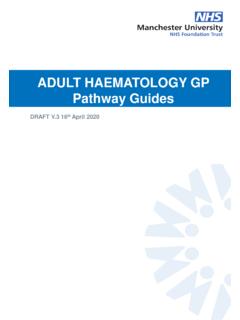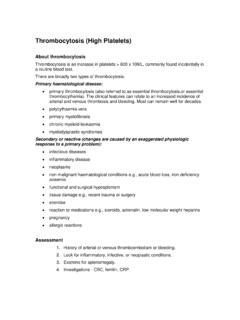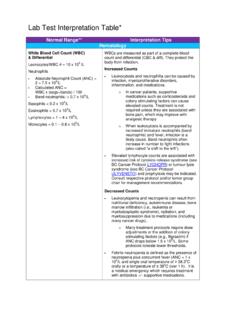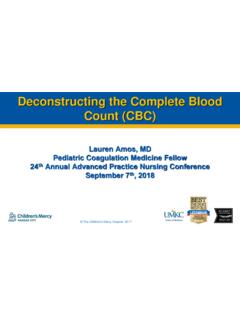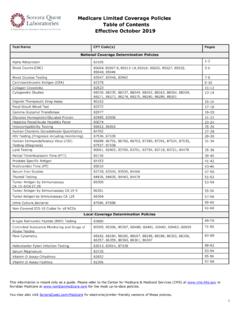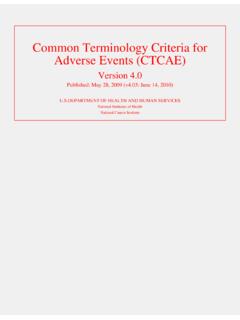Transcription of Complete Blood Count
1 Complete Blood CountAndrea Dean MDAssistant ProfessorHematology/Oncology Red Blood Cells (RBCs) Hematocrit (Hct) Hemoglobin (Hgb) Mean Corpuscular Volume (MCV) Mean Corpuscular Hemoglobin(MCH) Mean Corpuscular Hemoglobin Concentration (MCHC) Red cell distribution width (RDW) White Blood Cells (WBCs) Platelets Mean platelet Volume (MPV) CBC COMPONENTS Transport hemoglobin which carries oxygen from the lung to tissues throughout your body Produced in the bone marrow and stimulated by erythropoietin which is made in the kidneys M: to m/uLF: to m/uLRBCH emoglobin :M: to gm/dL F: to gm/dLHematocrit : Percentage of the volume of whole Blood that is made up of red Blood cells.
2 (Hint: Hb x 3)M: 38 to 54 % F: 34 to % HEMOGLOBIN AND HEMATOCRIT MCV =mean corpuscular volume HCT/RBC Count = 80-100fL small = microcytic normal = normocytic large = macrocytic MCH=mean corpuscular hemoglobin Hb/RBC Count = 27-34 pg decreased = hypochromic normal = normochromic Increased = hyperchromicMCV and MCHC MCHC = mean corpuscular hemoglobin concentrationHb/HCT = 32- 36 gm/dl RDW = red cell distribution widthIt is correlates with the degree of anisocytosis or variation in red Blood cell range from 10-15%MCHC and RDW HemoglobinElevated Primary erythrocytosis-Polycythemia Vera Secondary erythrocytosis-Chronic hypoxia(COPD, heart disease, high altitude)-Elevated erythropoietin due to malignancyLow AnemiaHow to Approach Anemia Decreased production of RBC s- ex.
3 Bone marrow failure, nutritional deficiencies Increased destruction of RBC s- ex. hemolysis Loss of RBC s- ex. bleedingMicrocytic< 80 flMCVN ormocyticMacrocytic> 100flIron Deficiency IDAC hronic InfectionsThalassemiasSideroblastic AnemiaChronic diseaseEarly IDAS ickle cell diseaseCombined deficienciesBlood lossB12/Folate deficiencyHemolysisMDSMCV DifferentialHypoproliferativeHyperprolif erativeRetics < 2 Retics > 2 Nutritional deficiencies Chronic disease Bone marrow failureHemolytic anemiaChronic Blood lossRetic Count DifferentialMicrocytic AnemiaIron Deficiency Anemia(IDA)Iron related testsNormalIDAS erum Ferritin (pmo/L)33-270< 33 TIBC ( g/dL)300-340> 400 Serum Iron ( g/dL)
4 50-150< 30 Transferrin Saturation %30-50< 10 RDW10-15%> 15%MCH27-34<27 Retic Count -< 2 STAGES OF IRON DEFICIENCYM arrow iron +++NoneNoneNoneFerritin40- 200 20-3010-15< 10 MCV NormalNormalSlightlymicrocyticMicrocytos isAnemia AbsentAbsentAbsentPresentTIBC NormalNormalNorma or IncreasedIncreasedSerum Iron60- 150< 40< 20< 10 Transferrin Sat % 20-5030<15< 15 Etiology of Iron Deficiency Blood loss-GI, menstruation, hemoptysis, dialysis Increased iron requirements-Pregnancy, erythropoietin therapy Inadequate iron supply-Poor dietary intake, vegan, malabsorption(IBD, celiac disease, gastric bypass)Treatment for IDA Oral iron is first line treatment (ferrous sulfate/gluconate)A.
5 Ca-tums, Phosphate, antacids absorptionB. Ascorbic acid (orange juice) absorption Reserve parenteral Rx. for oral intolerance Packed cell transfusion in emergency Continue Fe Rx at least 3 months after normal HbMacrocytic Anemia -B12(Cobalamin) and Folate deficiency-Drugs (hydrea, 5-FU, MTX, HIV meds)- Liver disease/alcohol-Hypothyroidism-Myelodysp lastic Syndrome-HemolysisEtiology of B12/Folate DeficiencyB12 Impaired absorption-Gastric atrophy, PPI, *Pernicious anemia, Gastric bypass, Crohn s disease, Celiac disease Poor dietary intake-Strict vegan Defect in transportFolate Impaired absorptionCrohn s disease,Celiac disease, decreased duodenal and ileal absorption Poor dietary intake-*Tea and toast diet, Alcoholism Increased requirements-Pregnancy, hemolysisB12(Cobalamin)
6 Deficiency Symptoms : weakness, depression, memory loss, unsteady gait and clumsiness (posterior and later columns degeneration) Diagnosed by B12 levels< 200 pg/ml Methylmalonic acid and homocysteine elevated in early deficiency Tx: oral B12 or B12 IM injections Folate Deficiency Symptoms: Similar to B12 deficiency, except no neurological symptoms Diagnosed by folate < 2 ng Tx with folate 1-5mg/dayNormocytic Anemia1. Chronic disease2. Early IDA3. Hemoglobinopathies(SCD)4. Primary marrow disorders5. Combined deficiencies( ex: Iron+B12)Anemia of Chronic Disease(AOCD) Thyroid diseases Malignancy Collagen Vascular Disease-Rheumatoid Arthritis-SLE-Polymyositis-Polyarteritis Nodosa IBD Ulcerative Colitis Crohn s Disease Chronic Infections HIV, Osteomyelitis Tuberculosis Renal FailureIron Deficiency Anemia vs AOCDIDAAOCDS erum ferritinDecreasedNormal or increasedSerum IronNormal or decreasedNormal or decreasedTIBCI ncreasedNormal or decreasedIron saturationDecreasedNormal or decreasedMCVD ecreasedNormal or decreasedBone marrow ironDecreasedNormal or increased WBCs are involved in the immune response The normal range: ^9 K/L Two types of WBC.
7 1) Granulocytes consist of: Neutrophils: 50 - 70% Eosinophils: 1 - 5% Basophils: up to 1% 2) Agranulocytes consist of:- Lymphocytes: 20 - 40% Monocytes: 1 - 6% White Blood Cells (WBC)Neutrophilia an increase in neutrophils Bacterial infections Tissue destruction (burns) Inflammation (SLE, RA, UC) Thyrotoxicosis Cigarette smoking Corticosteroids B-agonist LeukemiaNeutrophilNeutropenia a decrease in neutrophils Decreased bone marrow production Medications ( ex. dapsone, cephalosporins) Immune related (ex. SLE, RA) Post acute infection (HSV, CMV, HIV, EBV)NeutrophilEosinophilia: increased eosinophil Count Parasitic infections Allergic conditions and hypersensitivity reaction Aspergillosis VasculitisEosinopenia SepsisEosinophil Lymphocytosis increased lymphocyte count_ Viral infection( EBV, CMV, HIV, Infectious ) mononucleosis-Leukemia/Lymphoma (CLL) Lymphopenia decreased lymphocyte count_Viral infections_Medication induced_ Autoimmune disorderLymphocyteMonocytes Monocytosis-Pregnancy-TB-Syphilis-Sarcoi d Monocytopenia- Acute infection- Steroids-LeukemiaPlatelets Platelets/thrombocytes principal function is to prevent bleeding The normal range is 150-400 K/UL Numbers of platelets Increased ( thrombocytosis )
8 Splenectomy Inflammation(Reactive) Myeloproliferative disease (ET) Iron deficiency anemia Decreased (Thrombocytopenia) TTP, DIC, ITP, HIT** Blood loss Splenomegaly Medications ( antibiotics) Viral Infections ETOH abuse Bone marrow disorder (leukemia) Platelets
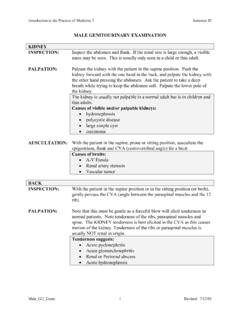
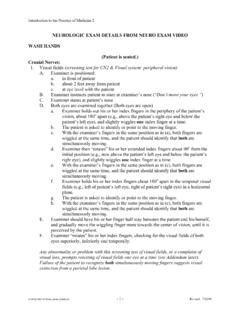

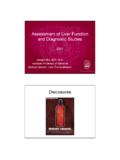
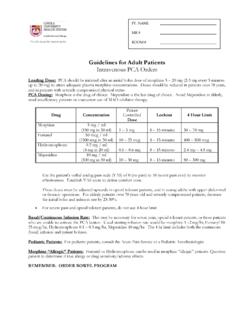

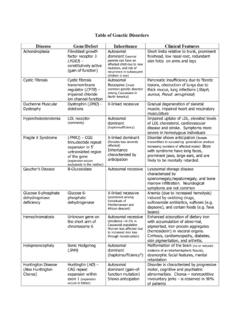

![WOUND HEALING lecture.ppt [Read-Only]](/cache/preview/2/b/6/c/1/4/7/f/thumb-2b6c147f08025508ccf4ec201274f3ba.jpg)
